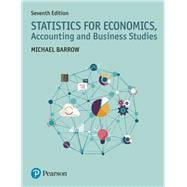Increase your confidence in Statistics and build up your skills for excellence with this reader-friendly guide to the field.
Statistics for Economics, Accounting, and Business Studies, 7th Edition by Michael Barrow is a user-friendly, comprehensive introduction to the subject, offering a variety of statistical tools and techniques that will help you build your skills and knowledge in Mathematics and Economics.
Ideal for students of economics and the closely related disciplines of accountancy, finance, and business, this is an easy-to-follow text that does not require prior knowledge of Statistics. The book guides you through the essential principles of the field and provides a thorough analysis of statistical concepts and methods.
This latest edition will offer you new and updated content regarding topics, such as statistical reports, graphs, and hypothesis testing. The text also includes updates to demonstrate recent examples and real-life data.
With a plethora of features to support, practice, and test your understanding of the discipline, this essential learning resource will help you solve real-life economic problems, providing an insight into the relationship between statistical techniques and relevant concepts.









